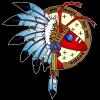Scientific Name: Lasius umbratus
Distribution: Widespread over much of Eurasia and North America. (See distribution map in the Antwiki link near the bottom)
Queen size: 5-7 mm
Worker size: 4-5.5 mm
Natural Habitat: They usually nests under rocks, but also occur in rotting wood (including the timbers of houses), at the foot of trees, or in open ground.
Circadian Activity: Mostly nocturnal but are still active in the day. Rarely seen due to predominately subterranean habits.
Mating Flight: They fly anywhere from May to October depending on climate and location. The main flights usually occur in May.
Queen Founding Method: Temporary social parasite. In the wild the queen will kill one or two workers of the host species, usually Lasius niger, to gain the colony scent before infiltrating the colony and killing the resident queen. In captivity it is possible to provide pupae to a queen for an easier colony founding process.
Monogyne or Polygyne: Strictly monogyne
Average time from egg to worker: Egg to Larvae = 15-18 days; Larvae to pupae = 10-15 days, Pupae to worker = 14-18 days.
The colonies may grow fairly quickly, depending on the workers present and amount of food supplied.
Recommended Temperature: 70-75°F (21 -23°C)
Recommended Humidity: They seem to like a dryer nest 25-30% humidity.
Preferred Foods: Meal worms, Honey water. Most sugary foods and insects are readily accepted.
Hibernation Details: In the wild temperatures below freezing are common, even up to -40C/F. In captivity it is advised to stay above the freezing point as we are unable to easily duplicate the slow cool down into freezing temperatures. Hibernation is recommended between 39F (4C) - 50F (10C).
Escape Barrier Methods: Fluon and talcum powder method work best.
Difficulty rating: They are a difficult species to keep, simply due to the process a parasitic queen has to undergo to start her colony. If Lasius pupae or callow workers can be obtained and provided to a new queen the process can be much simpler.
Bite and/or Sting rating: N/A
Special Care or Interesting Notes: Lasius umbratus is a social parasite, the new queens are unable to start a colony on their own, and so they go on the hunt for a colony of similar species to infiltrate their nest. The L. umbratus queen will wait for a worker of the host colony to kill and steal the colony scent. After being accepted by the colony she works her way to the host queen and kills her, then uses the workers from the host nest to raise her first brood. As time goes on the host colony dies off and she is left with only her own offspring.
There are several possible ways to accomplish the founding process:
They can be placed in test tube with host workers and brood from another similar species, after a week or so they will hopefully get comfortable with each other, and the workers will start to feed the queen. Soon after the queen will lay her eggs and the host workers will help her to start her colony. They cannot start a colony by themselves they need host workers. They will need to be monitored daily, to make sure they are getting along, sometimes the queen will kill the workers, and vice versa. Some people use cold temperatures to help them to accept each other. Just letting them do their thing is best.
OR
You can find pupae from a Lasius umbratus or other Lasius species and provide them the to queen. Once they eclose, they will accept her as their queen. You may have to feed the queen a tiny drop of sugar water every couple of days until the pupae eclose.
Additional Links:
http://www.antwiki.o...Lasius_umbratus
https://www.antweb.o...s&name=umbratus
Description:
The Queen - Clear yellow to reddish yellow; funiculus segments 2 to 4 slightly longer than wide. Scape elliptical in cross section. Petiole tapering to dorsal crest which is usually emarginate. Body surface and appendages covered in adpressed silvery pubescence. Longest hairs on gaster 0.06 mm to 0.11 mm, about half maximum hind tibial width. Erect hairs on genae, scapes and tibiae numerous.
The workers - of this species are yellow or pale brown ants, which have small eyes (35-65 ommatidia). The length of the longest hairs on the posterior half of the first gastral tergum (excluding those along the posterior strip) are less than ½ the maximum width of the posterior tibia at mid-length. The hairs on the first gastral tergum are spaced far enough apart that the distances between the tips of most or all hairs are greater than their lengths. Worker length: 3.8-5.5 mm
Information submitted by AntsMAN
Edited by dspdrew, March 5 2022 - 7:28 PM.




















